|
RMT Duros 8404
Fully-rugged Tablet PC for harsh environments
(by Conrad H. Blickenstorfer -- view review as PDF)
In February of 2008, RMT -- a subsidiary of Roper Industries that combines DAP Technologies, JLT Mobile Computers, and Black Diamond Advanced Technology -- introduced the Duros Rugged Tablet PC. The Duros 8404 is a fourth generation Windows XP-based tablet PC that is sealed to very high IP-65 specifications and passes all the requisite MIL-STD 810F ruggedness tests. Equipped with a sunlight-viewable 8.4-inch SVGA resistive touchscreen and powered by either a battery-saving AMD Geode LX 800 or a quicker 1GHz Intel Celeron M processor, the rugged Duros tablet comes with hard drives up to 120GB (or a solid state drive up to 64GB). The battery is hot swappable and the Duros can be equipped with integrated WiFi, Bluetooth, GSM/GPRS/EDGE/UMTS and optional GPS. Able to run a variety of different operating systems, this handy mobile tablet computer is geared towards harsh field applications such as mining, construction, utilities, public safety or military.
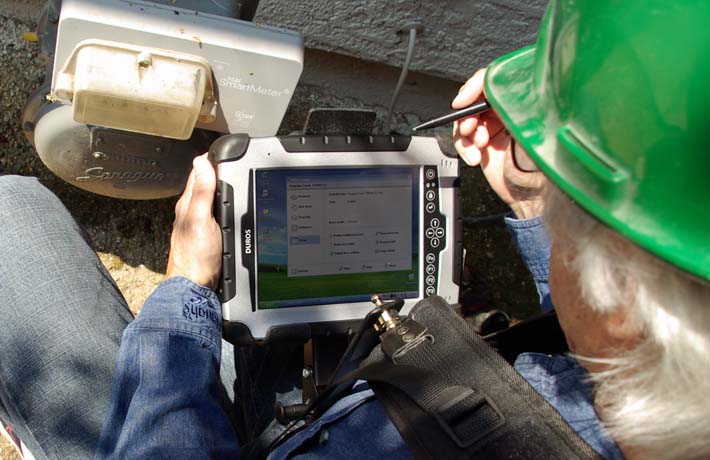
What are this computer's differentiating features? For one, it feels more solid than most even compared to other rugged machines. You never get the feeling that anything could break. It's as uncomplicated as it gets—a big plus in the field. There aren't a lot of doors and hinges and connectors and buttons; this is a reliable tool for tough jobs. Without a fan, the Duros operates silently. If you don't need certain wireless services you can simply turn them off. Same goes for the backlight; if you don't want to be seen at night you can turn it off completely. Quite clearly, a lot of thought went into making this machine as simple and straightforward as possible.
Display
The RMT Duros touch screen display measures 8.4 inches diagonally and has 800 x 600 pixel SVGA resolution. It is 100% dimmable, has a wider than average viewing angle (120 degrees), has an anti-reflective surface treatment that makes the screen pleasant to use compared to the garish (and nearly unusable for anything but watching movies) high-gloss screens that are currently so popular, and offers a degree of sunlight viewability.
The Duros screen has a strong 320 nits backlight (most consumer laptops have less than 200 nits) and special reflective treatment that makes it possible to use the computer outdoors.
The image below shows our review Duros with the standard 320 nits display outdoors on a bright, sunny California mid-morning, with backlight brightness set to maximum. The image is unretouched. As you can see, the display remains quite visible and screen surface reflection is not much of an issue.
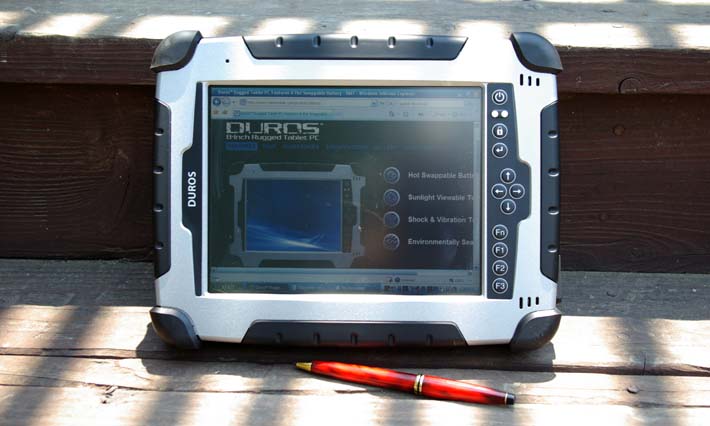
To the right of the display is an area with a number of hardware pushbuttons. In the center is a standard navigation diamond. On top of that power, enter and the Windows "security key" that brings up the task manager. Below the navigation diamond are a function key and three programmable keys. Function and the up/down key adjusts the screen brightness in 16 increments from screen-off to full bright. An indicator light shows whether the Function key is on or off by lighting either amber or green. The function keys are programmed with the Computer Configuration Tool (described below).
Processor choices
Creating a computer like the RMT Duros presents a design challenge that requires a carefully determined balance between several desired qualities. The device should be fast enough to satisfy users, but not so powerful that heat dissipation and battery drain become an issue. Battery life should be long enough for the targeted applications, but not to the extent where a large battery adds too much weight. Required processing power also depends on the operating system. Depending on its configuration, the Duros can run a range of operating systems starting with very lean ones like Windows XP Embedded or Linux or very resource-intensive ones like Windows Vista.
As a result, the designers of the Duros decided to offer two processor choices. For Windows XP Embedded or Linux there is a miserly 500MHz version of the AMD LX 800 processor. For Windows XP or above, RMT offers an Intel Celeron M ULV 373. The 373 is part of Intel's "Dothan" family, a 90nm ultra-low-voltage design that runs at a maximum speed of 1.0GHz, has 512MB of L2 cache, and has a Thermal Design Power (DTP) of just five watts. While this chip has been around for a few years, trivia heads might remember that this processor has 144 million transistors and is capable of serious work. It's also the same chip used in the much-discussed ASUS Eee PC mini notebook, so despite having been introduced back in 2005, the Celeron 373 remains an attractive choice.
That said, speed is totally relative in computers. Our tester came with Windows XP Embedded and the Celeron chip. It felt quite responsive and never fell behind. In order to see how the Duros with this configuration compares to other systems we installed Passmark Software's PerformanceTest 6.1. Passmark's benchmark suite runs about 30 tests covering CPU, 2D graphics, 3D graphics, memory, and disk and then computes scores for each category and an overall PassMark score. For comparison, we're listing the numbers of two systems that bracket the Celeron-equipped Duros. One uses a super-efficient 800MHz Intel A110 processor, the other a 1.2GHz version of Intel's more recent Core Solo. The results were as follows:
|
PERFORMANCE COMPARISON
|
RMT Duros
|
Motion F5
|
Getac E100
|
|
Processor
|
1.0GHz Celeron M 373
|
1.2GHz Intel Core Solo
|
800MHz Intel A110
|
|
Thermal Design Power (TDP)
|
5 watts
|
5.5 watts
|
3.0 watts
|
|
CPU Mark
|
249.5
|
324.9
|
207.2
|
|
2D Graphics Mark
|
169.1
|
153.8
|
174.7
|
|
Memory Mark
|
189.6
|
235.1
|
155.5
|
|
Disk Mark
|
189.4
|
168.8
|
200.2
|
|
3D Graphics Mark
|
54.5
|
75.6
|
63.1
|
|
Overall PassMark
|
169.7
|
194.4
|
148.3
|
Design and construction
Pick up this handy tablet and you know right away why RMT called it "Duros." It definitely feels durable. The chassis of the machine consists of an incredibly sturdy and solid aluminum case with an elegant silver powder coat finish. Below you can see a head-on as well as a bottom and side view.
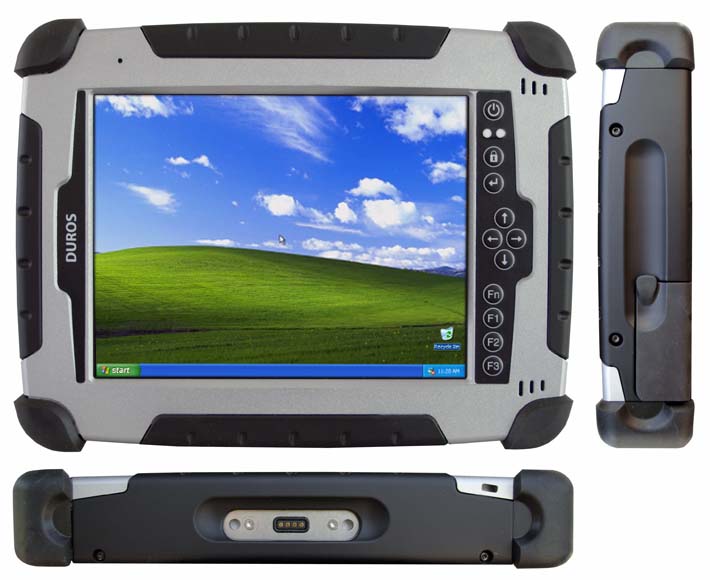
All four sides of the RMT Duros have thick rubberized plastic inserts that provide a secure grip and also cover some ports and other hardware (such as the sealed hard disk bay and the externally mounted antennae). All four corners have thick rubber bumpers that protrude about 3/16th of an inch from the surfaces of the case, thus providing maximum protection. The bumpers are screwed on and can easily be replaced should they get damaged. Anything that is screwed on the machine and shouldn't come off easily uses T9 Allen screws. That provides a degree of security as casual thieves may carry around a regular and perhaps Philips screwdriver, but T9 Allen drivers are not as common.
The IP65-sealed Duros does not have a lot of ports and openings to seal. Along the bottom is a docking connector with surface mount contacts. On the right side is an interface compartment with a USB port, a power jack, and a RJ45 port. They are covered and sealed with an attached friction-sealed rubber plug.
On the backside of the computer are two cutouts for mounting. Other than that, the backside is flat and completely free of doors or any other features.
The Duros design is such that it can be used both horizontally and vertically. The computer is equally as easy to hold in landscape as in portrait mode. The "Duros" logo is in portrait, as are the two small speakers. The buttons are arranged so that they can be used either way.
The 35 watt-hour Li-Ion battery is hot-swappable. If the computer is running out of charge in the field and you have a fully charged spare, simply remove the battery and pop the new one in. You don't even have to power down or even log out of Windows. Like everything else on the Duros, the battery is designed for quick replacement. You don't need a screwdriver or even a coin. Simply push a snap and the battery comes out.
On the back, the Duros has a handstrap with four elastic Velcro strips to adjust the strap to your hand. Should it break, or you do not want it for a deployment, remove it by undoing four Philips screws.
Wireless and expansion
Integrated wireless communication, once only available via add-on cards, has become pretty much standard equipment in most mobile systems. The RMT Duros is no different and comes with integrated 802.11a/b/g wireless LAN as well as Bluetooth Version 2.0 with EDR (Enhanced Data Rate) Class 1. Optionally available are cellular voice and data radios supporting the GSM/GPRS/EDGE, UMTS, and WCDMA networks. Also optionally available is an integrated high sensitivity GPS receiver.
The Duros does not have any externally accessible expansion cards as external card slots are notoriously difficult to seal. There is, however, an expansion port for grip integrated modules.
Computer Configuration Tool
A Computer Configuration Tool utility assists in setting up and personalizing the RMT Duros. There are four screens:
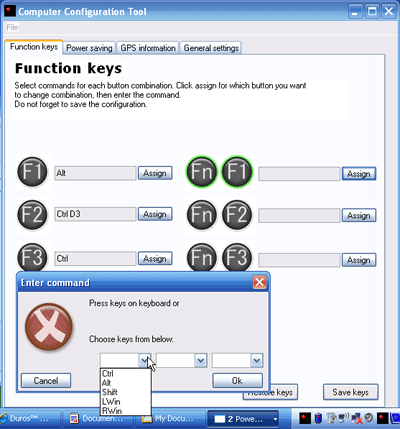
- Function keys let you program the physical function keys F1, F2 and F3 both by themselves and in conjunction with pressing the function key. You can either type in a command or select a sequence of keys from pulldown menus.
- Power Saving goes beyond the standard power saving modes available in Windows. For example, you can reduce power consumption by up to 20% by selectively disabling Bluetooth, WiFi or GPS when you don't need them. On this screen you can assign hotkeys to each type of radio so you can quickly turn them off and back on. The same panel also lets you set the brightness level when dimmed.
- GPS information shows whether the optional GPS receiver has a fix on satellites, how many satellites it has found, what their positions are, and a variety of other global position system data.
- General settings lets you autostart the Computer Configuration Tool and also serves for additional future and optional software/system settings.
The UPDD Console
The RMT Duros comes with the handy UPDD Console utility to manage a number of the unit's functions and to provide systems information. The available screens are as follows:
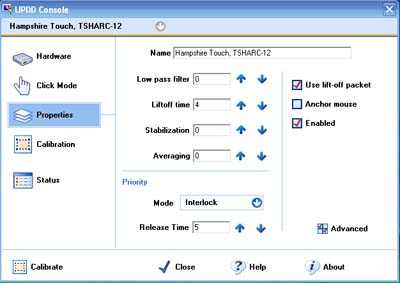
- Hardware: Tells you what USB port the touch screen uses, and how the desktop should be handled
- Click Mode: Lets you select the click mode (click and drag, drag then click, point and click, interactive touch), the switch delay, system mouse settings, as well as testing right clicks and double clicks.
- Properties: Some fairly advanced items for those who know how to fine-tune a touch screen: low pass filter, liftoff time, stabilization, averaging, priority and so on. There is also an advanced properties panel that lets you set edge acceleration of the touch screen and also lets you set the display so that touches outside of a calibrated area are ignored.
- Calibration: Lets you set the number of points (up to 25) that you use with calibration, the margin in %, as well as the timeout in seconds. The ability to calibrate 25 points instead of just four or nine increases accuracy and is much appreciated.
- Status: This screen shows a variety of fairly advanced diagnostics.
Every screen of the UPDD Console utility has a detailed help screen that explains all of the possible settings and configurations.
Operating Systems
RMT can ship the Duros with a variety of different operating systems. Those include Linux, Windows XP, the Windows XP Tablet PC Edition, Windows XP Embedded, and even Windows Vista. Which is best? That depends entirely on the intended application.
Our tester came with XP Embedded, and this requires a bit of explanation which those who are familiar with embedded operating systems can skip:
A general purpose OS, like Windows XP Pro, is just that, general purpose. You can do anything you want with it, and run anything you want on it. With that in mind, Microsoft equipped Windows XP with all the drivers and software and utilities one could possibly need. The result is a rather large OS with numerous processes and services running all the time, all consuming memory and power.
An embedded operating system is totally different. The idea is to only use what you need to perform a certain task and leave everything else behind. This greatly reduces the size of the operating system and dramatically reduces hardware requirements. XP Embedded is generally used for smart, connected and service oriented commercial and consumer devices that do not need all of Windows XP, yet can still run thousands of existing Windows applications. An embedded OS can easily be as small as 40MB and it's even possible to cut it all down to around 8MB with a bootable kernel.
XP Embedded is not one-size-fits all. A company will determine exactly what a machine is for and what it should be able to do. They then include as many components (hence the term "componentized" operating system) as they need. There are over 10,000 available and it's easy to create lean, nimble embedded OS platforms that can still do sophisticated high level tasks like advanced multimedia, browsing, communications or whatever a task requires. An embedded OS can even run as a real-time OS via third party plug-ins. Essentially you get the power of the basic Windows XP engine, but without any overhead you don't need.
What all of this means is that our Duros, running XP Embedded on the faster of the two processor options, was no slouch at all. In fact, it was downright speedy and never let us wait. We did not have a chance to use a Duros with Linux, but based on our Linux experience we'd expect Linux to run quite well on the Duros.
How about Windows XP Professional and the XP Tablet PC Edition? They would tax system resources quite a bit more. Which of the two would we choose? In general, the Tablet PC Edition shines on machines that have an active digitizer, which the touch screen-equipped Duros does not. On the other hand, manufacturers often include a good deal of Tablet PC functionality and utilities into XP Pro-based tablets, and so that might be a good option.
Given Vista's significant resource requirements we'd probably stay away from using it on a machine like the Duros, though if RMT says the machine can run Vista, it obviously can.
Ruggedness
The RMT Duros is a fully rugged machine designed to easily hold up to rough handling and demanding environmental conditions. The heavy-duty aluminum housing with its thick protective rubber bumpers on all four corners seems just about invulnerable.
The environmental spec sheet of the RMT Duros is quite impressive. The machine has a very wide operating temperature range of -4 to 122 degrees Fahrenheit, which means it can be operated in freezers and on other assignments where it will encounter freezing temperatures. If equipped with a solid state flash disk it can also survive the ultimate test of 26 drops onto concrete as mandated by MIL-STD-810F, Method 516.5 procedures. Water and dust protection is at the IP65 equivalent, where the 6 stands for total protection against dust, and the 5 for protection against low pressure jets of water from all directions.
The machine can handle 10 - 95% humidity; three hours worth of 5 - 500 Hz/4.5 g RMS vibration with a non-rotating disk; and survive 30 g of shock for 11 ms, again with the disk not rotating.
RMT also lists a variety of regulatory approvals that may or may not be relevant to specific customers. Approvals include Din 40050 Part 9 IEC 529; Safety: UL94, Class VO; FCC: Part 15, Subpart B, Class B; International Safety: CE; Electrical: ISO7632-1, reverse polarity, dual battery; EMC Susceptibility: ISO7637-2:2004; EN61000-4-2:1995+A1+A2; and EMC Emissions: EN55022: 1998+A2:2003, class B.
Vehicle dock and carrying harness
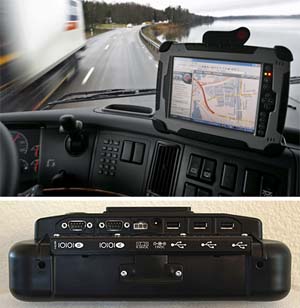 Rugged industrial tablet computers like the RMT Duros are mainly designed to be carried around and used in the field. However, many will also be used in vehicles, offices and even homes. This means they'll need mounting and docking solutions.
Rugged industrial tablet computers like the RMT Duros are mainly designed to be carried around and used in the field. However, many will also be used in vehicles, offices and even homes. This means they'll need mounting and docking solutions.
As a fully rugged machine, the RMT Duros does not have a lot of onboard ports as those often represent potential leaking areas. Instead, connectivity is primarily concentrated into an expansion connector that works with a port replicator/vehicle dock.
The vehicle dock is a very intelligently designed affair that adds a minimum of bulk and provides a maximum of connectivity and functionality. As can be seen in the image to the right, the standard dock has two DB-9 serial ports, three USB 2.0 ports and two power connectors -- one for the standard charger and one for 9-36 Volt DC vehicle power. The dock also has a fully integrated 1.5-inch fan to remove heat from the system unit.
The dock is designed for quick removal and insertion of the computer. There is no complicated insertion or locking procedure; you simply snap the Duros into the dock whose top provides spring-loaded tension to keep the computer secure. This is a simple and brilliant solution that lends itself for mounting in just about any vehicle.
When you use a rugged tablet in the field you may find yourself in situations where you need both hands free. That's where RMT's carrying harness (see picture below) comes into play. It is an ingeniously designed holster/harness that effortlessly lets you carry the Duros handsfree. It's made of plastic, metal and nylon-like straps. The harness goes over your shoulder and has two straps that go around your waist. The holster is designed so that it doesn't cut into shoulders. All straps can be adjusted for optimal fit.
The tablet itself snaps into a form-fitted ABS plastic support that can be rotated 360 degrees. The design is such that the computer can be locked into four different angles, from 90 degrees (flat) to 60 degrees, 45 degrees and folded up against the body when walking. It's a simple, yet brilliant design.
The RMT Duros rugged tablet computer: bottom line
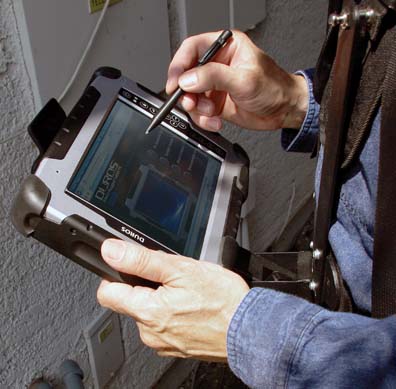 The Duros is a time- and field-tested rugged tablet computer made by one of the most respected manufacturers in the business. The platform is now in its 4th generation and that maturity is obvious in the design and implementation of the Duros. What you get here is a compact tablet with a footprint of 10.2 x 7.8 inches and weighing just over four pounds. The body is made of aluminum and feels exceedingly solid and invulnerable. Thick, and easily replaceable, rubber bumpers and plastic/rubber inserts on all sides further protect the computer and keep it from getting scratched or damaged.
The Duros is a time- and field-tested rugged tablet computer made by one of the most respected manufacturers in the business. The platform is now in its 4th generation and that maturity is obvious in the design and implementation of the Duros. What you get here is a compact tablet with a footprint of 10.2 x 7.8 inches and weighing just over four pounds. The body is made of aluminum and feels exceedingly solid and invulnerable. Thick, and easily replaceable, rubber bumpers and plastic/rubber inserts on all sides further protect the computer and keep it from getting scratched or damaged.
Unlike some of the competition which is now using the latest Intel Dual Core or Atom chips, the Duros makes do with much simpler and less expensive processors. You can get it with a minimalist 500MHz AMD LX 800 chip or a faster but still modest 1GHz Intel Celeron M processor. Both consume very little power and do not need a fan. Performance will depend on your choice of operating system. The Celeron processor was plenty fast enough for our XP Embedded test unit.
The 8.4" display has a responsive and very configurable touch screen and a pretty wide viewing angle. The standard display has a fairly strong backlight (320 nits) and can be used outdoors. A special sunlight viewable screen is optionally available.
The Duros is a very rugged unit that is totally sealed against dust and can also handle water jets from all sides. It has a very wide operating temperature range (-4 to 122 degrees Fahrenheit) and you generally never have to worry about it getting damaged.
Do not expect a lot of ports. Except for one USB and a LAN port, everything else is via dock. There are also no externally accessible expansion slots. The emphasis here is on simplicity and maximum sealing and reliability. This does not mean the Duros cannot be customized, however. There are wireless WAN as well as GPS options, making the Duros suitable for a wide variety of tough jobs.
-- Conrad H. Blickenstorfer
RMT Duros 8404 Specs:
| Type |
Rugged mobile tablet
|
| Processor |
500MHz AMD Geode LX 800 or 1GHz Intel Celeron M 373 |
| Display Chipset |
AMD Geode CS5536 or Intel Extreme Graphics 2 |
| OS |
Windows XP Professional, Windows XP Embedded, Linux
|
| Memory |
256/1024MB |
| Display |
8.4-inch/800 x 600 pixel, 120 degree viewing angle, with 320 nit backlight; Sunlight Readable option available |
| Digitizer |
resistive 4-wire touch |
| Keyboard |
Onscreen and optional USB mini-keyboard |
| Storage |
40-120GB hard disk; 512MB to 64GB solid state disk
|
| Expansion slots |
1 internal expansion slot
|
| Housing |
Aluminum, protective rubber bumpers |
| Size (inches) |
10.2 x 7.8 x 1.7 |
| Weight |
4.2 lbs.
|
| Operating temperature |
-4 to 122 degrees Fahrenheit |
| Ingress protection |
IP65 (meets IEC 60526) |
| Drop |
26 4-feet drops to concrete per MIL-STD-810F Method 516.5 (with solid state disk) |
| Power |
Hot-swappable Li-Ion 7.3V, 4,800mAH, 35 watt-hours, 9-21 VDC |
| Interface |
1 USB 2.0, RJ45, audio in/out, docking connector, stereo speakers |
| Wireless options |
802.11b/g, Bluetooth 2.0 + EDR; optional GSM, GPRS, EDGE, UMTS, WCDMA, GPS
|
| Price |
depends on configuration |
| Contact |
RMT, Inc. |
(copyright 2008 RuggedPCReview.com)
|



